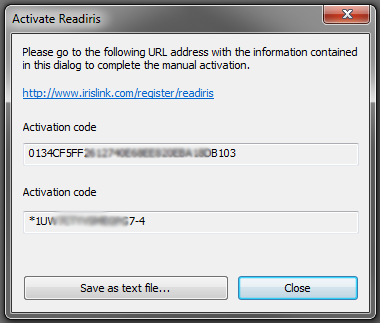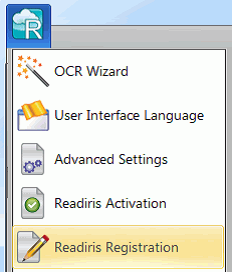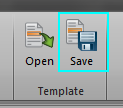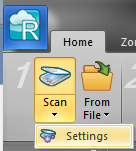Installation
1. Download issue
The username & password should not be necessary to access the FTP link. Use Firefox to bypass the need for that. Go to www.mozilla.com and download and install this alternative to Internet Explorer. Copy and paste the link below into the Address bar (not search) and hit the enter key on your keyboard. Save to your desktop where you can then double click to start the installation.
|
Activation
1. How do I get a software key?
When you start the Readiris™ software for the first time you will be asked to enter your serial number
You can use Readiris™ for 30 days without an activation key by choosing Register Later when the program starts up
To get the key choose Register now and you will have these options.
Click on Request the key button to send the key request. A key will be emailed to you within 24 hours
2. How do I activate Readiris?
Activation is a straightforward process. It requires an internet connection but does not request or transfer any of your personal information.
• Double-click the Readiris shortcut on the Desktop to start.
• You are prompted to activate Readiris. Click yes to do so.
• Enter the activation code you find on the label inside the DVD box.
Note: if you have a downloaded version, your activation code is located in your order email confirmation.
• Then click OK to finish the activation.
Remarks
• If you use Readiris on a virtual machine, you will have to activate it immediately
• The activation cannot be done through a remote connection of any kind. You need to be logged physically on the machine where Readiris is installed.
3. I get an error during the activation. What should I do?
If an error occurs during the activation process, you can process with the manual activation.
You will get the following popup

Check the following and retry:
• Firewall blocking outbound port
• If you have Read/write/modify access on the ReadirisPro14 folder (C:\ProgramData\Readiris14Corp) and lservrc file within
If the problem remains, please proceed with the manual operation
Click on Manual Operation and follow the instructions

|
Registration
1. How can I register Readiris?
Click the Readiris button in the top left corner of the interface, then click Readiris™ Registration.

Fill in the Registration form and click Register now.
Note that an internet connection is required to register.
2. What are the benefits of the registration?
Registering is required to get Technical Support.
It also offers other benefits, such as free updates, free trial downloads, video tutorials, discount on new products …
|
Updates
1. How can I update Readiris?
• Click the Readiris™ button in the top left corner of the interface.
• Then click Check for updates.
Remarks
• Readiris automatically checks for updates every 30 days.
• You need to be register in order to receive the updates
2. How can I register Readiris?
To register Readiris™, go on the Help menu; click Register Readiris to be directed to the Registration web page.
|
Usage and configuration
1. Readiris™ does not detect my Wireless scanner.
Please install Network Twain Drivers in order to solve this issue.
2. Readiris™ Crashes after Scanning
Verify that you have the latest scanner driver installed. You can check it on the scanner manufacturer's website
3. Drop2Read does not appear in Readiris™
Readiris™ 14 does not include Drop2read
4. Does Readiris™ 14 Corporate still support Business Cards?
No but Readiris™ 14 Corporate now comes with Cardiris™
5. There are no zones to be recognized on this page
"No zones defined" means that no zones were drawn to identify the text and other elements on the scanned document. Here are listed different reasons why you could have that message:
The page is not placed in the correct position and must be reversed.
The page is upside-down and must be rotated at 180°
No text could be defined because all the text on the original document is not enough contrasted (ex: dark characters on black background)
If you have only 1 blue frame (graphic frame) or no frames over the scanned image document and Readiris™ thinks then that it's only one big picture.
There is no text on the scanned document (e.g. a speckled white/blank page)
Readiris™ draws boxes around your document to indicate that it has identified text, images, tables or optionally barcodes and hand printing on your document. These boxes or zones are necessary to process the document correctly. If a zone is not present over a section then that area is ignored in the output and will not be included. By and large the program correctly identifies the elements on the page so just click "Recognize and Save" button, on the left side of the screen, to perform the recognition or conversion on your document.
6. How to improve the results in Readiris™?
Good recognition results are directly tied to image quality. If the input image is poor then so will be the results. The software works by converting pictures of character shapes into actual text. It the characters are touching or filled in because they are too dark or are broken up because they are too light then the software won't give you good results. It may in fact treat the text as an image with no conversion.
To improve the results you get using Readiris™, you should scan your document at 300 dpi in grayscale. By doing so, the image adjustment option will be available to help you process dark or light images. First go to the View menu and uncheck display documents in color. Go to view again and click on Actual Size. This will blow up the image so you can see the letter shapes to gauge how light or dark they are. When you inspect the document, the letters should not be touching each other, nor should they be filled in, faded or broken up.
Next go to Process on the file menu and choose Adjust Image. Move the brightness/Contrast slider and click apply. Repeat until satisfied with the appearance and then click OK.
7. Why doesn't the program work with all fonts?
The software works by comparing pictures of letter shapes to a database of known letter shapes. There are thousands of different kinds of fonts. Due to that it is impracticable to have every font type in the internal database. Moreover cursive, calligraphic or gothic fonts are not supported.
8. How do I use a template in Readiris?
The layout option is used to create templates and is most often when you want to apply the same zoning across a range of images. For books, manuscripts or legal documents a single orange text zone often produces the best results.
a. Document already scanned
Delete the current zones go to Zones tab
Select "Delete All Zones"
Draw the desired zones on your image
Go to Template section and click on Save. Give it a descriptive name

Go to Template section > click on open, choose the file you just saved
Check the "apply to all pages check box" if you want it applied to all images.
b. Document has not yet been scanned
Go to Home Tab > Configuration section"
Uncheck the option "Page Analysis"
Scan your documents
Draw the desired zones on your image
Go to Template section and click on Save. Give it a descriptive name
Go to Template section > click on open, choose the file you just saved
Check the "apply to all pages check box" if you want it applied to all images.
9. Readiris™ is scanning only the first 50 pages of my document
Readiris™ Pro can process up to 50 pages at a time.
Readiris™ Corporate has no page limit, and also includes more features like automatic file conversion without any clicks (also called "batch OCR" or "watched folder").
/readiris
If you are opening a file in Readiris™, a way around the page limitation is to open a specific range of pages in the open dialog in Readiris™.
10. I get the error "Cannot Open TWAIN default source"
Readiris™ does not load any drivers of its own; it instead makes use of the driver installed with the scanner software.
See article "how do I configure my scanner with Readiris™?"
11. Excel Output
Usually the conversion problem in Excel is the grid lines. When they are incomplete or broken in the image then the software does not know what to do with those line fragments.
It is preferred to set it to Excel (*html) and the Layout to create body text by either clicking on the Format button on the left bottom or right clicking on the smart task in the center of the screen.
12. Readiris Output File Formats
There are two separate ways to output from Readiris™. Either in the Send to, which uses a script to send the results to the output application or in the External File which saves the file and opens it in the associated application.
Note: for the "send to" option: the target application should be installed on your machine.
PDF
Portable Document Format is a file format created by Adobe Systems Inc to enhance document exchange. Documents in PDF are independent from device and display resolution and can be read on any operating system (Windows, Macintosh, and Linux). These files are a combination of vector graphics, text, and raster graphics. They support links (internal and external), forms, JavaScript and 3D objects. PDF documents may have different levels of encryption (view, print, select…) and even DRM. Since the 90's, Adobe's PDF has become the standard file format for document exchange. Readiris™ supports four different configurations. This format is used for documents for storage or transmittal where editing the text is not needed.
Image over Text - Used for most purposes. Image of document overlays converted text.
Text over Image - Rarely used but maintains unified images in the background for easy capture by desktop publishing programs.
Text only - No image layer, only converted text.
Image only - No text layer.
RTF
Rich Text Format is a free document file format developed by Microsoft in 1987 for cross-platform document interchange. Most word processors are able to read and write RTF documents. Most word processing software supports RTF format import and export, often making it a "common" format between otherwise incompatible word processing software. RTF is capable of the same formatting precision as Microsoft .doc format without the threat of macro viruses. RTF is used by default in Readiris™ for documents sent to Microsoft Word and is appropriate when the goal of the conversion is to edit the final document or repurpose the text. Readiris™ provide options to choose what level of formatting accuracy is desired.
- Create body text
Use this option if you don't want Readiris™ to format your document. You get continuous, running text with no differences in fonts or font sizes. All formatting, if any, is done afterwards by the user.
- Retain word and paragraph formatting
This option keeps the general format structure of the scanned document. However, no graphics are captured, the text blocks and columns aren't recreated - the paragraphs just follow each other. The tables are recaptured correctly.
- Recreate source document. This option will make a true copy of the document you just scanned. The text blocks, tables and graphics are recreated in the same place, and the word and paragraph formatting are maintained across the document. These sub options are available depending on what degree of final editing is required.
- Use columns instead of frames Uses columns instead of text boxes (frames) to position the information on the page
- Insert column breaks Confines text to the column where located instead of flowing to the next column
(DOCX)
Word Markup Language was introduced as the standard format in Word 2007 and continued in Word 2010 and is based on XML (extensible markup language) replacing the binary format used in previous versions of Word. Available only using the external file option.
DOC
A binary format containing text formatting information (as well as scripts and undo information) used by Microsoft Word versions prior to Word 2007.
Available only using the external file option.
HTM
Hypertext markup language is the predominant markup language for web pages. It provides a means to describe the structure and formatting of text-based information in a document. This format can be used my Microsoft Excel or a Web browser such as Internet Explorer. Additionally it can be used to send the result to a web page editor like Adobe Dreamweaver. When used for Excel there are two relevant formatting options.
- Create body text
Straight text using the same font and font sizes. There will be no text wrapping or merging of cells.
- Retain Word and Paragraph Formatting
Maintains fonts and font sizes. Text wrapping and merging of cells will be used to position elements on the page
Spreadsheet ML
SpreadsheetML is an XML dialect developed by Microsoft to represent information in an Excel workbook. It was introduced in Excel 2003 and is the default format in Excel 2007 & 2010. The same formatting options for html also apply here. In this format there are these additional options.
- Ignore all text outside of tables
Will include only the spreadsheet itself, no information outside the grid will be included
- Convert Figures into numbers
Numbers as text will be converted to numbers
- Create one worksheet per page
One worksheet is created per scanned page. If a page contains tables and text, all will be placed on the same worksheet.
- Create one worksheet per table
One worksheet is created per table in scanned page(s). Useful for tables of different sizes or headings
CSV
Comma Separated Value is a text format for storing tabular data which uses a comma to separate values. It is usually associated with Excel on Windows machines. Since it can only display a single table it is sometimes referred to as a flat file.
TXT
Comma Separated Value is a text format for storing tabular data which uses a comma to separate values. It is usually associated with Excel on Windows machines. Since it can only display a single table it is sometimes referred to as a flat file.
- ANSI or ISO-8859
A single byte format for display and editing of plain text using Latin characters. Traditional format used for Window now being replaced by Unicode
- UTF-8 or Unicode
A double byte format capable of displaying Asian, Arabic or Cyrillic characters along with the traditional Latin character set.
The next discussion is how to decide what format to choose
13. How do I configure my scanner with Readiris™
There are two places to set the scanner in the program. This assumes that
· Check if you have installed the latest available TWAIN drivers for your scanner / Windows combination.
· The scanner is connected to the computer and switched on.
1. Go to Home tab > Scan > Settings > Configure.

This is the most important because this is where you choose which device you want to use from the list that may be connected to your computer.
That can include scanners, cameras or web cams. There should be a specific choice for your scanner. If this window is empty then the scanner driver never got loaded. Install from your scanner CD or download from the manufacturer's website.
2. Go to Scanner Model.
This is to set a profile to be used with the item selected above. Not all scanners have specific profiles in which case you use a generic profile. In most cases you will use (TWAIN) or <TWAIN> <Other Models>
If your scanner has an automatic document feeder look for the ADF check box which is the on/off switch for using that feature.
NOTES:
I.R.I.S. does not provide drivers as they are designed and engineered by your scanner manufacturer.
Contact the scanner support for further help with the installation of the scanner drivers.
14. Readiris Format settings
The Readiris™ is OCR software that can convert your scanned image into a text document. The first thing it does is analyze the page and puts color coded boxes over various sections of the document to tell you what it intends to do with the various sections if converting to a text based format.
Create body text.
Use this option if you don't want Readiris to format your document. You get continuous, running text with no differences in fonts or font sizes. All formatting, if any, is done afterwards by the user.
Retain word and paragraph formatting.
This option keeps the general format structure of the scanned document. However, no graphics are captured, the text blocks and columns aren't recreated - the paragraphs just follow each other. The tables are recaptured correctly.
Recreate source document.
This option will make a true copy of the document you just scanned. The text blocks, tables and graphics are recreated in the same place, and the word and paragraph formatting are maintained across the document. These sub options are available depending on what degree of final editing is required.
- Use columns instead of frames
Uses columns instead of text boxes (frames) to position the information on the page
- Insert column breaks
Confines text to the column where located instead of flowing to the next column
Example: with Microsoft Word.
These boxes can be manipulated and change to suit your needs.
This is not perfected technology because of the nearly infinite variations in text, formatting and image quality. Because of that it is inevitable that there will be some mistakes when sending to Word.
If you are getting boxes in the Word document then make this settings change in Readiris™ and reprocess.
Go to Settings > Text Format and look under the layout Section/Tab. If only the Recreate source document is selected then it uses text boxes to position the elements on the page.
The solution is either to check the Use columns instead of frames or revert to Retain Word and Paragraph formatting.
15. My scanner model is not listed
Not all scanners have specific profiles in which case you use a generic profile. In most cases you will use (TWAIN) or <TWAIN> <Other Models> |
|